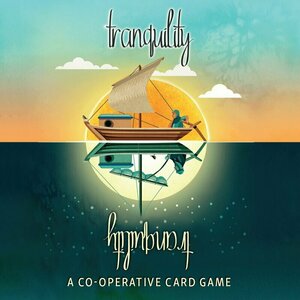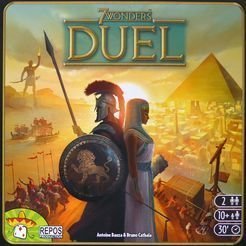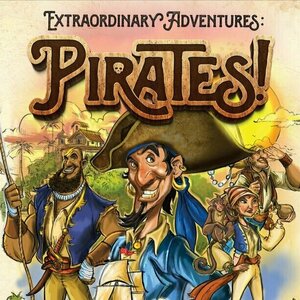Purple Phoenix Games (2266 KP) rated Tranquility in Tabletop Games
Oct 21, 2021
Tranquility is a cooperative hand management, tile placement card game for one to five players. In it players will be attempting to create a sea of islands around which they sail their boat towards infinite paradise. They will accomplish this by laying numbered cards from their hand in numerical order before any of the players run out of chances to play a card. Oh, and there’s also no talking during the game. That’s kind of a big deal.
DISCLAIMER: We were provided a copy of this game for the purposes of this review. This is a retail copy of the game, so what you see in these photos is exactly what would be received in your box. I do not intend to cover every single rule included in the rulebook, but will describe the overall game flow and major rule set so that our readers may get a sense of how the game plays. For more in depth rules, you may purchase a copy online or from your FLGS. -T
To setup the standard game, place all the border cards around a 6×6 grid, as in the photo below. Shuffle the appropriate number of Start and Finish cards into the deck of Island cards and place that beside the grid. Draw a hand of five cards and the game may begin. Setup is similar to the multiplayer setup, with a few changes. Once the hand of cards has been drawn, the game may begin! It is the solo player’s goal to build the sea of island cards, and place the Start and Finish cards before they run out of cards to be legally played.
The game is played over many turns. Each turn players will be either playing a card from hand or discarding two cards. When a player plays a card from hand to the grid, they may place it anywhere they wish within the grid. The goal is to have each card placed numerically in order beginning from the lower left of the grid in a zig-zag pattern left to right, then ascending to the next highest level. In other words, the play area would be ordered numerically as English-speaking people read, but from the bottom up instead of the top down – like a reverse typewriter.
When a card is played, the player may choose to place it in its own area, or immediately next to another card already in play. If the new card is placed adjacent to an existing card, the player must discard cards equal to the difference between the values of the two adjacent cards. For example, if a 12 is placed next to a 14, then the player would need to discard two cards after placement. If a card is placed that is already in direct numerical order, no discards are needed. Again, a card at the right-hand edge of a row is adjacent to the card on the next row higher on the left-hand edge, and this is the most difficult aspect of the game to grasp for new players.
Should a player instead wish to discard two cards for their turn, they do so to their discard pile. After each action (playing a card or discarding two cards) the player will draw back up to their hand of five cards.
Eventually, the player will happen across the Start and Finish cards. In the solo game, when a Start card is placed (outside the grid, but in amongst the border cards in the lower left-hand corner), the player will need to draw eight cards from the draw deck, keep four, and discard the remaining eight. This eats up cards from the draw pile and draws the game closer to the end. When the grid is completed and all the numbered cards are in numerical order, the player may then play the Finish card to end the game. If all cards are properly placed the player wins! If not, they must try again. Probably immediately, because it is that kind of game.
Components. This game is a bunch of square cards in a cubic box. Now, while that doesn’t sound super exciting, the art on the cards certainly make up for the lack of component diversity. Each card is matte finished, which I prefer for cards with great art on them. And oh man, that art is something wonderful! I have always been a fan of Tristam Rossin’s art, and it is on full display here. The cards are, well, I guess I cannot find the correct word because they aren’t double-sided, but split on the horizontal, with a daytime scene on the “top” and a nighttime scene on the “bottom” (or vice-versa, however you feel). I have nothing but praise for the components here.
The gameplay is familiar in feel, but definitely a little different and a whole lot of fun. Fans of The Mind will find this familiar in that the game is structured around silent players building a grid/stack of numerically appropriate cards until the win condition is met. However, I have not been able to play The Mind solo, and Tranquility comes with solo rules in the box. So that’s a win in my book.
Now, Tranquility solo is no cakewalk. No, there are no other players to make crazy decisions to throw off any tactics planned, but you most certainly can misjudge where to place a card, and then be married to its position as you try to fill in all the appropriate cards around it. I learned that all too early when I decided my first game that I should try to divide the grid into equal sections and approximate where a 48 should go. Well, I’ll tell you now that a 48 has absolutely no business being a row above a 19 (check the photo above if you don’t believe me). Silly choices like this make for an afternoon of pondering optimal placements when unboxing your next play, and that brings a smile to my face. Any time I think about a game the next day or several days later and it entices me to play again with a different strategy, I feel is the mark of a great game.
I have yet to play this with a group (damn COVID), but I know the people I play with are going to love this one. And, honestly, I am going to love the peace and quiet as the game plays out, so I can think about my turn and then think about a different possibility once someone ruins my plans. But I tell you what, even as a solo game, this one is great. I am quite happy to keep this as a pure solo experience, but I do want to try it once with others. We do not typically give out ratings for Solo Chronicles reviews, but this one would be pretty high, I’m telling you now. Okay, I have to go get the boat ready and pack my cooler. Enjoy Tranquility!

Tournament Fishing: The Deckbuilding Game
Tabletop Game
Tournament Fishing is a card game that involves memory, luck, and strategy. Each participating...

Kingdomino
Tabletop Game
In Kingdomino, you are a Lord seeking new lands in which to expand your kingdom. You must explore...
BoardGames TilelayingGames FamilyGames

Leaving Earth
Tabletop Game
The year is 1956. Mankind stands at the dawn of a new age, the Space Age, when the flying bombs of...

Sailing toward Osiris
Tabletop Game
Pharaoh is dead and his funerary barge sails slowly down the Nile toward his tomb where his spirit...
BoardGames 2018Games EgyptianGames
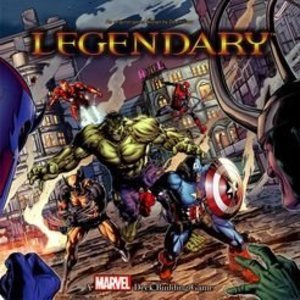
Legendary: A Marvel Deck Building Game
Tabletop Game
Legendary: A Marvel Deck Building Game is set in the Marvel Comics universe. To set up the game,...
Purple Phoenix Games (2266 KP) rated 7 Wonders Duel in Tabletop Games
Oct 26, 2021
7 Wonders: Duel is a 2-player tableau and engine-building card game set in the 7 Wonders game universe where players collect cards to create an engine to gain VP using any number of winning strategies. The game takes place over three ages and the player with the most VP at the end of the game, becomes victorious via military supremacy, or wins via scientific supremacy.
To setup, place the game board between the players with the green Progress tokens, Military tokens, and red Conflict pawn upon it. Shuffle the Age I cards and lay them according to the rule book (this formation changes for each age. Age I is setup in the photo below). Each player receives seven gold and they draft their Wonders according to the process in the rules.
On a turn the active player will choose one uncovered face-up card to be used one of three different ways. The card can be added to the player’s tableau and “built” by spending resources required, if any. The card may be discarded in exchange for coins totaling 2 + the number of yellow cards built in the player’s city. Lastly, the card may be used to build a player’s Wonder card by inserting it below the Wonder and paying the cost, as in 7 Wonders proper. The next player will then take their turn.
If on a turn a player builds certain card types into their city, special actions are taken. This happens as a result of building Military or Science cards. When a player builds a Military (red shield icon) card they immediately move the Conflict token on the board one space toward their opponent’s Capital (the end of the board closest to the opponent). Should a player force the Conflict token to reach their opponent’s Capital, the attacking player immediately wins! The other special action that can be taken is with a pair of Science cards being built. For every pair of like-symbol Science cards built, the active player may choose to take one of the Progress tokens from the game board and add it to their collection. These tokens can be very powerful, and just as in 7 Wonders proper, Science is a viable yet difficult strategy. Should a player build any six unique Science icons on cards they will immediately win!
If a Military or Science supremacy victory is not achieved, the game continues to Age II, where setup of the cards is different, but play remains the same. Similarly, Age III is setup differently still and has the added bonus of three random Guild cards, which may add significant strategic icons or abilities. At the end of Age III the players count their VP from the various sources listed in the rule book and the ultimate champion is then crowned!
Components. This game comes in a very small box, so the components are also quite small. I believe myself to have medium-sized man-paws and I have not had any issues with size of components. They are all very high quality, as is to be expected from Repos Production, and are fantastically illustrated. The Conflict token is enticingly menacing, and it lures me into concentrating on a Military victory every time I play. I need to just ignore it, but it’s so beautiful! All in all, the components are great, and even though the cardstock is relatively thin, my copy has withstood many plays and has seen very little wear and tear.
So 7 Wonders: Duel exists for all those players who love 7 Wonders but do not wish to play it with the 2-player variant rules. While Duel is certainly a little sibling, it is also its own beast of a game and should be treated as such. There are several key changes in rules for Duel, such as the trading with the BANK for missing resources upon building versus paying a neighbor to borrow their resource production. Also, the obvious change of adding a board with an ever-dancing Conflict token is unique to this title. Wonders are treated differently and instead of receiving one Wonder with three layers, Duels gives each player four Wonders with just one layer.
Aside from the differences between the two games, I do believe that if you are a fan of one you will also like the other. I can see, though, gamers who dislike 7 Wonders enjoying the smaller 7 Wonders: Duel. There is just something about being able to focus on one other player and agonizing over every turn so that your opponent receives a useless card from the offer, or taking every Military or Science card possible so as to end the game as quickly as possible. My brother, Bryan, greatly dislikes 7 Wonders, but he does not mind playing Duel, or at least that is what he led me to believe…
Myself, though, I think I still prefer original 7 Wonders, and I believe it is because I can soar through a game of it in under 15 minutes while holding a conversation with the other players (as long as they have played before and are very comfortable with the rules). Duels creates a more intimate feeling and eats up more of my brainpower. Purple Phoenix Games has awarded 7 Wonders Duel the coveted Golden Feather Award, so we agree that this is a fabulous game. If you have been waffling over grabbing a copy of Duels, please do yourself a favor and just purchase it! I promise you will have a great time with it, and if you end up disagreeing with me, let me know. We can play whatever you like next time we meet.
Purple Phoenix Games (2266 KP) rated Extraordinary Adventures: Pirates in Tabletop Games
Jul 16, 2021
Pirates is a piratey, deck-building, racing game for two to six players attempting to reach Trinidad with the most VP and greatest booty (interpret that as you will). To setup, lay the humongous board on the table and populate the merchant ship locations with the appropriate number of supply crates pulled blindly from the bag. Each player will place one of their ships on the starting locations of each of the three tracks upon the board. Shuffle the Merchant Deck and place it in its position on the board face-down. Shuffle the Port Deck and set it near the board face-down but reveal the top three cards as the offer. Shuffle the treasure tiles and reveal a number of them equal to three times the number of players plus one more. Give each player their starting deck to shuffle and then draw five as a starting hand. The race may now begin!
On a player’s turn they will play three cards from their hand and “move their ships accordingly” says the rulebook. Initially we were not sure if that meant movement cards could all be played to the same ship or each of the three cards needed to be assigned to each of the player ships on the three different tracks so we decided to use the latter rule logic. Cards will contain a number in the lower right hand corner to signify how many spaces a ship may move this turn. Some cards will also have a special power written beside the movement number that may be used instead of the movement. The starting deck contains one card that will be able to thin the deck using this type of special power.
When a player’s ship meets either a Merchant ship or moves into a Port the movement ends immediately to resolve these encounters. When plundering a Merchant ship players will simply swipe the supply crates from the board and draw a Merchant card to their discard pile. When in Port, players will be able to draw one of the face-up Port cards in the offer or the top card from the face-down draw deck. In addition, players will be able to use the supply crates collected as currency to purchase the revealed treasure tiles near the board for VP at game end. Once all card have been played and subsequent actions played as a result the next player takes their turn. Play continues in this fashion until one ship reaches Trinidad and ends the game. The pirate captain with the most VP from cards, treasure tiles, and placement on each track will be the winner with the greatest booty (not in the rules, but I like to play that way).
Components. We were impressed with the components in Raccoon Tycoon, but Pirates scores well above it in component impressiveness. The board is massive and features incredible art. It looks just like a map and it’s simply gorgeous. The cards are all fine quality and the art on them is very good. The true component stars in this game are the supply crates and the player ships. Okay, so I love playing games that feel deluxe. I’m sure I’m not alone with that statement, but when I tell you that these little crates are amazing I meant it. How easy would it have been to just throw in a bunch of colored wooden cubes like 98% of games and call it a day? Easy peasy. But no, not good enough. Pirates goes the extra mile and gives us molded plastic (or resin, idk I’m not a chemist) boxes that look like supply boxes. And the pirate ships? The same super incredibly quality. They are minis where standees could have worked just fine. And they are DETAILED. I love them so much. Components score a big time happy face from us.
But the gameplay. Components are great but make the game they do not. However, having these great components only enhance the already wonderful gameplay here. I love deck-building games and it might be my favorite style of game. I also genuinely love when games throw in additional styles to complement the deck-building. Don’t get me wrong, we all love our Legendary: Marvel DBG (it’s a Golden Feather Award winner after all), but that’s just straight up deck-building. I quite enjoy another little deck-builder that adds a map and an additional way to use the deck-building cards in harmony: Trains. In Pirates we have deck-building paired with racing on a giant board. It just fits the piratey theme so well and combines deck-building with what I love from the game Jamaica.
It’s no surprise that I personally rated this quite high. Though not all our team has had a chance to play it yet, I believe they would all love it as much as I do. Purple Phoenix Games gives Extraordinary Adventures: Pirates! a plunderingly wunderful (I did that on purpose) 11 / 12. Want to add to your deck-building experience with a race using excellent components and art? Pick up a copy from your FLGS today!
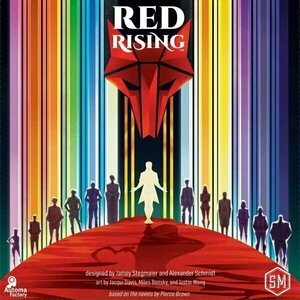
Red Rising
Tabletop Game
Enter the futuristic universe of Red Rising, based on the book series by Pierce Brown featuring a...
